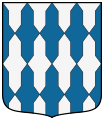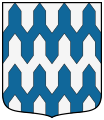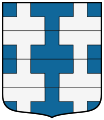Vair

Vair(/vɛər/;fromLatinvarius"variegated" ), originating as a processed form ofsquirrelfur,gave its name to a set of different patterns used inheraldry.Heraldic vair represents a kind of fur common in theMiddle Ages,made from pieces of the greyish-blue backs of squirrels sewn together with pieces of the animals' white underbellies. Vair is the second-most commonfur in heraldry,afterermine.[citation needed]
Origins[edit]
The wordvair,with its variant formsveirandvairé,was brought intoMiddle EnglishfromOld French,fromLatinvarius"variegated",[1]and has been alternatively termedvariorum opus(Latin, meaning "variegated work" ).[2]
The squirrel in question is a variety of theEurasian red squirrel,Sciurus vulgaris.In the coldest parts of Northern and Central Europe, especially theBaltic region,the winter coat of this squirrel is blue-grey on the back and white on the belly, and was much used for theliningofcloakscalledmantles.It was sewn together in alternating cup-shaped pieces of back and belly fur, resulting in a pattern of grey-blue and grey-white which, when simplified in heraldic drawing and painting, became blue and white in alternating pieces.[2]
-
A unit of the heraldic furvair,pointing downwards
-
Vair fur
-
Vair ancien
-
Barry of six vair and gules, arms of theLords of Coucy
-
Dark morph of Eurasian red squirrel
-
Enamel image from the tomb ofGeoffrey, Count of Anjoushowing a vair-lined mantle
Variations[edit]
In early heraldry, vair was represented by means of straight horizontal lines alternating with wavy lines. Later it mutated into a pattern of bell or pot-like shapes, conventionally known as panes or "vair bells", of argent and azure, arranged in horizontal rows, so that the panes of one tincture form the upper part of the row, while those of the opposite tincture are on the bottom.[i]The early form of the fur is still sometimes found, under the namevair ondé(wavy vair) orvair ancien(ancient vair)(Ger.Wolkenfeh,"cloud vair" ).[ii]The only mandatory rule concerning the choice of tincture is the respect of the heraldicrule of tincture,that orders the use of a metal and a colour.[3]
When the pattern of vair is used with other colours, the field is termedvairéorvairy[iii]of the tinctures used. Normally vairé consists of one metal and one colour, although ermine or one of its variants is sometimes used, with an ermine spot appearing in each pane of that tincture. Vairé of four colours (Ger.Buntfeh,"gay-coloured" or "checked vair" ) is also known, usually consisting of two metals and two colours.[3][4]
Traditionally vair was produced in three sizes, and each size came to be depicted in armory. A field consisting of only three rows, representing the largest size, was termedgros vairorbeffroi(from the same root as the English wordbelfry); vair of four rows was simplyvair,while if there were six rows, representing the smallest size, it wasmenu-vair(whence the English wordminiver). This distinction is not generally observed in English heraldry, and is not strictly observed in continental heraldry, although in French heraldry it is customary to specify the number of rows if there are more than four.[3][4]
Arrangement variants[edit]
There are also forms of vair in which the arrangement of the rows is changed. The most familiar iscounter-vair(Fr.contre vair), in which succeeding rows are reversed instead of staggered, so that the bases of the panes of each tincture are opposite those of the same tincture in adjoining rows. Less common isvair in pale(Fr.vair en palorvair appointé,Ger.Pfahlfeh), in which the panes of each tincture are arranged in vertical columns. In German heraldry one findsStürzpfahlfeh,or reversed vair in pale.Vair in bend(Fr.vair en bande) andvair in bend sinister(Fr.vair en barre), in which the panes are arranged in diagonal rows, is found in continental heraldry.Vair in point(Fr.vair en pointe,Ger.Wogenfeh,"wave vair" ) is formed by reversing alternate rows, as in counter-vair, and then displacing them by half the width of a pane, forming an undulating pattern across adjoining rows. German heraldry also uses a form calledWechselfeh,or "alternate vair", in which each pane is divided in half along a vertical line, one side being argent and the other azure.[3][4]Any of these may be combined with size or color variations, though the variants which changed several aspects are correspondingly rarer.
-
Vairé gules and or
-
Counter-vair
-
Vair in pale
-
Vair en pointe
Potentand other shapes[edit]
Potent[iv](Ger.Sturzkrückenfeh,"upside-down crutch vair" ) is a similar pattern, consisting of T-shapes. In this form, the familiar "vair bell" is replaced by a T-shaped figure, known as a "potent" due to its resemblance to a crutch. The pattern used with tinctures other than argent and azure is termedpotentéorpotentyof those colours. The appearance of this shape is thought by some authorities to have originated from crude draftsmanship, although others regard it as an old and perfectly acceptable variation. A regularly encountered variation of potent iscounter-potentorpotent-counter-potent(Ger.Gegensturzkrückenfeh), which is produced in the same fashion as counter-vair;potent in point(Ger.Verschobenes Gegensturzkrückenfeh,"displaced counter-potent" ) is also found, and there is no reason why one could not, in principle, havepotent in bend,potent of four colours,etc.[3][4]
Three other, rarer furs are also seen in continental heraldry, of unclear derivation but most likely from variations on vair made to imitate other types of animals: inplumetéorplumetty,the panes are depicted as feathers; and inpapelonnéorpapellonythey are depicted as scales, resembling those of a butterfly's wings, whence the name is derived. In German heraldry there is a fur known asKürsch,or "vair bellies", consisting of panes depicted hairy and brown.[3][4]Here the phrase "vair bellies" may be a misnomer, as the belly of the red squirrel is always white, although its summer coat is indeed reddish brown.
-
Potent
-
Counter-potent
-
Potent in pale
-
Potent in point
-
Counter-potenté gules and or
-
Plumeté or and sable
-
Gules, papelonné or
-
Kürsch
-
Kürsch
See also[edit]
References[edit]
- ^Usage varies as to whether the panes in the upper part of each row should be argent or azure. There is no rule, but following the reasoning that metals are more "honourable" than colours, the leading authorities suggest that argent should come first. This is the usual practice in French heraldry, but in British armory the top row is usually azure.
- ^As with many heraldic terms, the Norman French spelling is commonly used, even in English heraldry; but the Anglicized form,vair ancient,is also found.
- ^Sometimes, in older authorities,varryorverry.
- ^Occasionally,varry cuppy.
- ^"Vair".American Heritage Dictionary of the English Language, 4th ed.New York:Houghton Mifflin Company. 2000.
- ^abVeale, Elspeth M.:The English Fur Trade in the Later Middle Ages,p. 224.
- ^abcdefWoodward and Burnett,A Treatise on Heraldry,pp. 68–71.
- ^abcdeFox-Davies,A Complete Guide to Heraldry,pp. 79–83.
This article incorporates text fromA. C. Fox-Davies' 1914 edition of Charles Boutell's
- The Handbook to English HeraldryatProject Gutenberg,which is in thepublic domainin theUnited States.
- Veale, Elspeth M.:The English Fur Trade in the Later Middle Ages,2nd Edition, London Folio Society 2005.ISBN0-900952-38-5



















